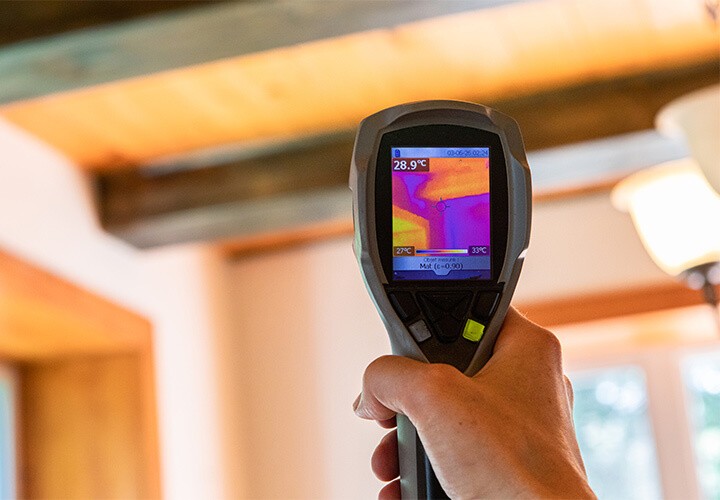Resources & Information
Is Your New Build Losing Energy?
The excitement of stepping into your brand-new home is often accompanied by the meticulous task of creating a snagging list. But while you're focused on those immediate fixes, have you considered the long-term cost of heating a new build?
Visible imperfections are undoubtedly important, but beneath the fresh paint and pristine finishes could lie silent culprits impacting your long-term comfort, rising energy bills and even the structural integrity of your property, such as inadequate insulation and poor thermal performance.

While the summer sun is here, thoughts of winter's chill might seem distant. However, now is the prime time to prepare for winter insulation upgrades; it's also the ideal period to scrutinise the very fabric of your new build's thermal envelope. Why? Neglecting this crucial aspect and blindly trusting that Building Regulations and your NHBC warranty have you fully covered could lead to years of discomfort, inflated energy costs and potentially complex rectification down the line.
Why New Builds Aren't Always Thermally Sound
It's a common misconception that a brand-new home, built to current regulations and backed by the NHBC, is inherently energy-efficient and free from insulation defects. While regulations set minimum standards and the NHBC provides a valuable safety net, several factors can lead to discrepancies.
Building Regulations define the minimum acceptable standards for different parts of your home. Builders might adhere to these minimums without necessarily striving for the best energy efficiency. This means your home could technically pass regulations and snagging, but still be costing you more to heat and cool than necessary.
Even with high-quality insulation materials, the effectiveness hinges on proper installation. Gaps, compression, incorrect layering, or missed sections can create pathways for heat to escape in winter and enter in summer, which can impact energy performance. These concerns about insulation aren't always obvious and won't necessarily trigger a Building Regulations failure on a standard inspection.
The NHBC's main concern is whether the build complied with the Building Regulations at the time of construction. They are less likely to step in for issues of sub-optimal performance or if the insulation technically meets the minimum standard, even if it's poorly installed. Once walls are plastered, floors are laid and ceilings are finished, visually inspecting the quality and continuity of insulation becomes virtually impossible. Waiting until you experience rising energy bills makes diagnosis and rectification far more disruptive and costly.
The Strategic Window for Thermal Investigation:
While the warmth of summer isn't the time to conduct a thermal imaging survey, it's the ideal time to plan for one. Here's why:
- Early Awareness and Budgeting: Thinking about a thermal survey now allows you to factor it into your overall new home assessment and budget accordingly.
- Research and Choosing a Provider: You have the time to research qualified and reputable thermal imaging specialists in your area, like IPGL, so you can understand their processes and pricing.
- Understanding the Ideal Conditions: You can learn about the optimal conditions for a thermal survey, typically during the colder season when there's at least a 10-15 degree Celsius temperature difference between inside and outside.
- Documenting Potential Problem Areas: As you live in your new home over the summer, you might notice certain areas that feel consistently warmer than others, or areas prone to condensation. Note down these concerns about insulation, as they could be points of interest for a future thermal survey.
- Engaging with Your Developer Early: If you have any initial concerns about insulation based on your observations or energy bills (once you start incurring them), you can raise these with your developer now and mention your intention to conduct a thermal survey during the cooler months. Understanding these issues early can help manage the long-term cost of heating a new build.


Integrating Thermal Awareness into Your Summer Snagging:
Don't just rely on your eye for snags. Equip yourself with knowledge and consider these steps:
- Demand Documentation: Request detailed specifications of the insulation materials used for walls, roof and floors. Ask for any energy performance certificates (EPC) and understand the predicted energy efficiency of your home.
- Look for Subtle Clues: While you can't see inside the walls, be aware of temperature inconsistencies between rooms or unusual drafts. These could be early indicators of insulation gaps or thermal bridges.
- The Power of Thermal Imaging: Seeing the value of thermal imaging, consider investing in a professional survey. A certified thermographer can use specialised equipment to identify areas of heat leakage (in winter thinking) or excessive heat gain (in summer thinking) with remarkable accuracy. This visual evidence is invaluable for discussions with your builder and potential NHBC claims.
- Ventilation Awareness: Proper ventilation works hand-in-hand with insulation. Ensure extractor fans in kitchens and bathrooms are functioning correctly and that trickle vents in windows (if installed) are open when needed to prevent moisture buildup, which can negatively impact insulation performance.
- Don't Delay: Address any concerns about insulation or thermal performance with your developer as soon as possible. Document all communication and findings.
Investing in Your Home's Future Performance
Your new build is more than just bricks and mortar; it's an investment in your future comfort and financial well-being. By extending your snagging focus beyond the cosmetic and proactively investigating the unseen world of insulation and thermal performance, especially during this strategic summer window, you're safeguarding that investment.
Don't wait for rising energy bills or uncomfortable drafts to suspect insulation problems. Use this summer to be strategic: understand that new builds can have insulation issues, learn about thermal imaging as the key to identifying these hidden defects and plan your survey for the cooler months.
Contact IPGL today to learn how a thermal imaging survey can be an integral part of your comprehensive new home assessment.